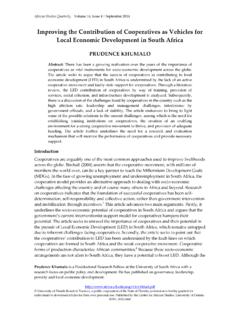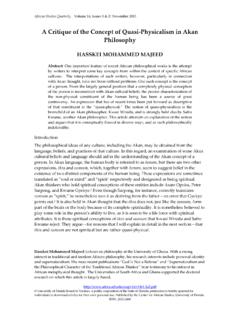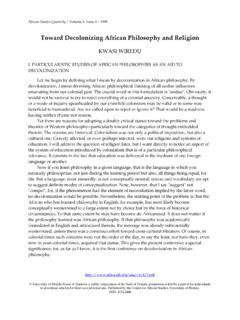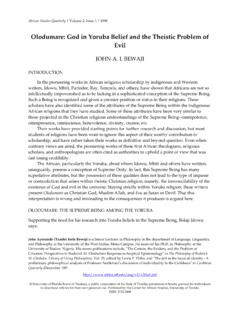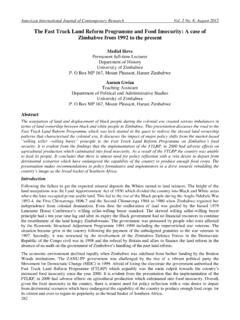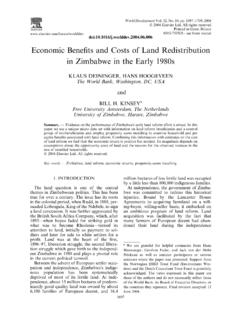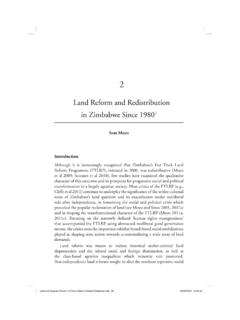Transcription of The Experience of Resettled Farmers in Zimbabwe
1 African Studies Quarterly | Volume 7, Issues 2 & 3 | Fall 2003 Sophia Chiremba is a doctoral student at Purdue University, and a graduate of Africa University in Mutare, Zimbabwe . William Masters is a Professor of Agricultural Economics at Purdue University, who worked at the University of Zimbabwe and the Zimbabwe Ministry of Lands, Agriculture and Rural Resettlement during 1988-90. University of Florida Board of Trustees, a public corporation of the State of Florida; permission is hereby granted for individuals to download articles for their own personal use. Published by the Center for African Studies, University of Florida. ISSN: 2152-2448 The Experience of Resettled Farmers in Zimbabwe SOPHIA CHIREMBA AND WILLIAM MASTERS Abstract: This study assesses the relative productivity of smallholder Farmers in Zimbabwe s land reform and resettlement programme.
2 We use a panel of survey data collected in 1992, 1993, 1996, and 1997 from up to 400 Resettled households, who in 1981-84 had been moved onto previously large-scale commercial farms in three distinct agro-ecological regions. A sub-sample of 166 households were surveyed in all four years, and for 1997 we have data from a comparable survey of 147 Farmers in communal areas (CAS). Using these data, we ask whether and how the Resettled Farmers productive efficiency might have converged to their area s efficiency frontier over time, and whether particular farmer characteristics or institutional interventions might have helped them to improve faster. Applying Data Envelopment Analysis (DEA) methods to measure productive efficiency, we find that although individual Farmers often moved towards higher efficiency levels, there was no trend towards the frontier, and Farmers improvements were not consistently correlated with receiving formal credit or extension services, having more Experience or education, or using more farm equipment.
3 In sum, despite the relatively large and uniform land area available to each farmer, they had widely varying productivity levels, not overcome by conventional farm services. Introduction With the advent of majority rule in 1980, the government of Zimbabwe (GoZ) adopted the goal of growth with equity . New policies included bringing underutilized land into full production and reducing the inequality in land The first phase of the land reform and Resettlement Program (LRRP1) began in 1980, which by 1997 had redistributed million hectares to 71,000 families from communal areas well below the initial target of million hectares and 162,000 A second phase of resettlement (LRRP2) was begun in 1998, followed by an accelerated fast-track resettlement phase in June 2000, and then the announcement of an end to land redistribution in August Although it has been more than two decades since the start of Zimbabwe s resettlement Experience , this massive socioeconomic change remains relatively unstudied.
4 The official government critique of resettlement a decade after its implementation views the program as a failure. The program failed to have a positive impact on agricultural productivity and rural incomes .4 Von Blanckenburg concludes that in the first decade of land reform , the GoZ failed sufficiently to take care of productivity in the new resettlement sub-sector. Another opinion and perhaps a more widely shared view is that Zimbabwe s initial resettlement program was slow but remarkably successful by historical standards .5 98 | Chiremba and Masters African Studies Quarterly | Volume 7, Issues 2 & 3 | Fall 2003 Nonetheless, there remain considerable disparities between resettlement areas and communal areas, and within the resettlements.
5 The Ministry of Lands admitted that although a number of settlers are already achieving the recommended income targets, a group of Farmers is emerging for whom the benefits of being Resettled are very marginal .6 Most studies of Resettled Farmers use the panel of surveys known as the Zimbabwe Rural Household Dynamics project (or Kinsey data), which sampled some of the very first Farmers to be Resettled in the early 1980s. Analyses using these data have addressed productivity, asset accumulation, diversification, consumption smoothing, welfare indicators (mainly health and child nutrition), the effectiveness of relief and development assistance, evidence of structural adjustment impacts, gender dimensions, the role of government services, and access to and use of In this study, we use the Kinsey dataset in a new way, to ask whether and why some Resettled Farmers are performing less well than others.
6 The paper first discusses agricultural land distribution in Zimbabwe and describes its resettlement programme. This sets the stage for our own analysis of Resettled Farmers Experience . By using non-parametric efficiency measurement we compare each farmer to every other farmer in the survey, and quantify each farmer s distance from the frontier of the most productive Farmers in their area. With this approach, we test whether Resettled Farmers productivity is influenced by more farm equipment, credit availability, extension, education, or other support services such as membership in farmer organizations. The result is a quantitative test of whether and how Resettled Farmers can discover or be taught how best to farm in their new environment.
7 AGRICULTURE AND land DISTRIBUTION IN Zimbabwe Agricultural Systems The dual agricultural system inherited from the colonial era divided Zimbabwe into two sectors: a large-scale commercial (LSC) sector controlled by white settlers from Europe, and a small-scale (SS) sector controlled by indigenous people. Small-scale farming was further subdivided into small-scale commercial (SSC) areas and communal areas (CAs), plus the later resettlement areas (RAs). As in other countries, Farmers with less land tend to use it more intensively, and Zimbabwe s LSC Farmers actually plough only a small fraction of potentially arable land . They typically run cattle on land that smallholders would have ploughed resulting in well over half of the national beef herd being reared on relatively high-potential arable land .
8 8 One source estimated the percentage of underutilized arable land in the LSC areas at about 40-50% in high potential agro-climatic regions l, II, and 85% in lower-potential region As shown in Table 1, the national-average cropping intensity of LSC farms was 4%, as compared to a cropping intensity of 11% in CAs and 8% in RAs. Current figures on cropping intensity could not be obtained to update these 1994 data. However, the total area in RAs has increased from million ha as of 1994 to an estimated million ha of mostly model A1 resettlement farms in The Experience o f Resettled Farmers i n Zimbabwe | 99 African Studies Quarterly | Volume 7, Issues 2 & 3 | Fall 2003 TABLE 1. land Use by Farming Area CAb LSCFc RAd SSCe Total AVERAGES Area per farm (ha/hh)a 18 2,500 38 125 - Of which: area planted (ha) 2 103 3 7 - Cropping intensity (%) 11 4 8 6 - TOTALS Total Area (million ha) ( )f ( ) (0) ( ) Total Area (%) Number of Farms ( 000s) Source: Adapted from Masters, 1994; Commercial Farmers Union (CFU) of Zimbabwe , 2002;UNDP report, 2002.
9 A hectares per household b Communal Areas c Large scale commercial farming areas comprising CFU and non-CFU farms, indigenous Farmers unions farm and large estates owned by multinationals. d Resettlement arease Small scale commercial farming areas f 1980 figures are in brackets land Use and Production LSC farms are highly mechanized with widespread use of irrigation and chemical spraying equipment as well as land preparation, planting and harvesting equipment. But these resources are concentrated on their best and most conveniently located land , while their other land is left to Also, the LSC sector as a whole is more diversified than SS farming, including wildlife ranching as well as horticulture and many niche products, but individual LSC Farmers tend to be more specialized than individual SS Finally, LSC farms are much more market-oriented, contributing about 40% of market delivery of maize, cotton, groundnut, 90-100% of market delivery of wheat, soyabean, tobacco, coffee, tea and sugar cane, 80% of all commercial beef sales and virtually all milk deliveries to the Dairy Marketing Board; supplying about a third of the raw materials to local manufacturing.
10 And, contributing about 50% of all export earnings via exports of tobacco, maize, cotton, beef, etc in the normal The Ministry of Lands, Agriculture and Rural Resettlement reported in 1992 that the LSC Farms had provided 72% of the national production value of all major crops since 1983 100 | Chiremba and Masters African Studies Quarterly | Volume 7, Issues 2 & 3 | Fall 2003 Smallholder Farmers in Zimbabwe generally engage in subsistence mixed farming. Livestock provides animal draught for tillage, transport, manure, milk, meat, some cash income, and a stock of Crop production provides most of the food for the household, which may also sell or buy some land preparation is mostly by ox-drawn plough, some weeding is done by ox-drawn cultivator, and some transportation is by ox-drawn Some SS Farmers and few CA and RA Farmers own or hire tractors and other mechanical equipment.
